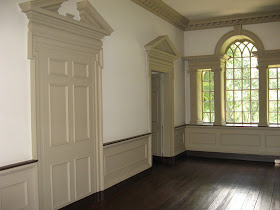In the last entry I established that on the north side of Fountain Green was the neighboring estate called Mount Pleasant built by sea captain John Macpherson in 1763. On the other side of where Fountain Green used to be, is the house called the Cliffs. The Cliffs was built in 1753 by Philadelphia merchant Joshua Fisher, a Quaker (1707-1783). Like Mount Pleasant and Fountain Green, the estate surrounding the house included a farm, although in general, life in this region was not an agrarian economy. Many farmed and sold their crops, but capital stemmed mainly from trade, shipping, law, banking and real estate (Meeker excelled at a number of these!)
 se customers could receive reasonably priced goods within weeks. Joshua became wealthy, and started the first packet line of ships to sail regularly between Philadelphia andLondon.
se customers could receive reasonably priced goods within weeks. Joshua became wealthy, and started the first packet line of ships to sail regularly between Philadelphia andLondon.Moving his family to downtown Philadelphia in 1746, Joshua built the Cliffs as a country getaway for the summers (for fun and to get away from the fever epidemics which would sweep through the city). It signaled his socioeconomic “arrival” and showcased his newfound wealth.
The house remained in the Fisher family for more than 100 years until the Fairmount Park Commission purchased it (and all the other villas in the confines of the ‘new’ park, an early example of eminent domain?) in 1868. The house was rented and maintained until the 1960s when it became vacant. The house had a substantial amount of woodwork and paneling. It was taken over and repaired in the 1960s by the Shackamaxon Society, a local civic group.
Incredibly, the Cliffs was vandalized in the 1970s & 80s, possibly due to publicity that the Fairmount Park Commission allowed city officials to live in the park's 45 historic houses rent-free. As a result of the news stories, the Park Commission decided to charge rent, but renters could not be found for some of the houses. Those that were occupied were thereby protected and maintained. The Cliffs was unoccupied from 1970, and due to a lack of funds, neither the Park Commission nor the Shackamaxon Society could maintain it.
The Cliffs burned on February 22, 1986, due to vandalism and arson. Firefighters were unable to extinguish the fire because their heavy trucks sank in the clay earth surrounding the house. The clay had been trucked into the site in order to cover an area near the house used as a dump for refuse from various municipal construction projects. (info courtesy of wiki, as is the photo of the ruin)
 Satellite image of The Cliffs by googleearth, this is how it is today!
Satellite image of The Cliffs by googleearth, this is how it is today! I knew I only had 3 days in Philadelphia, to explore and to research, but one of the things I really wanted to do was find this burnt out shell, so close to Fountain Green, which would have meant slashing my way through brush and bramble! In the satellite image, the road is below the railroad tracks, and the tracks are set up high. With limited time and no one to join me in such an excursion, I did the less adventurous route, and took an appropriate tour of Mount Pleasant. In the next entry, I will show the satellite view of all three properties.
I knew I only had 3 days in Philadelphia, to explore and to research, but one of the things I really wanted to do was find this burnt out shell, so close to Fountain Green, which would have meant slashing my way through brush and bramble! In the satellite image, the road is below the railroad tracks, and the tracks are set up high. With limited time and no one to join me in such an excursion, I did the less adventurous route, and took an appropriate tour of Mount Pleasant. In the next entry, I will show the satellite view of all three properties. 


